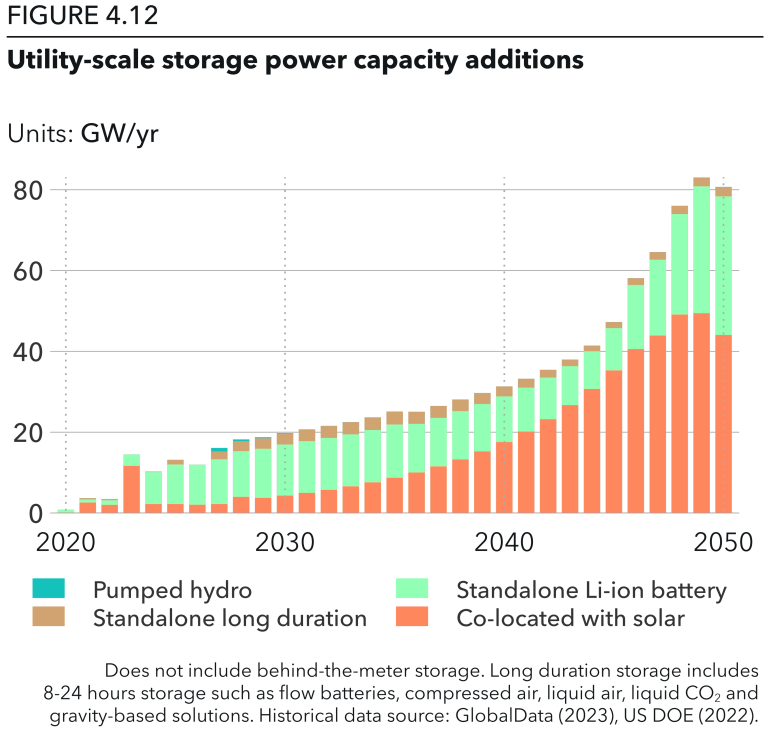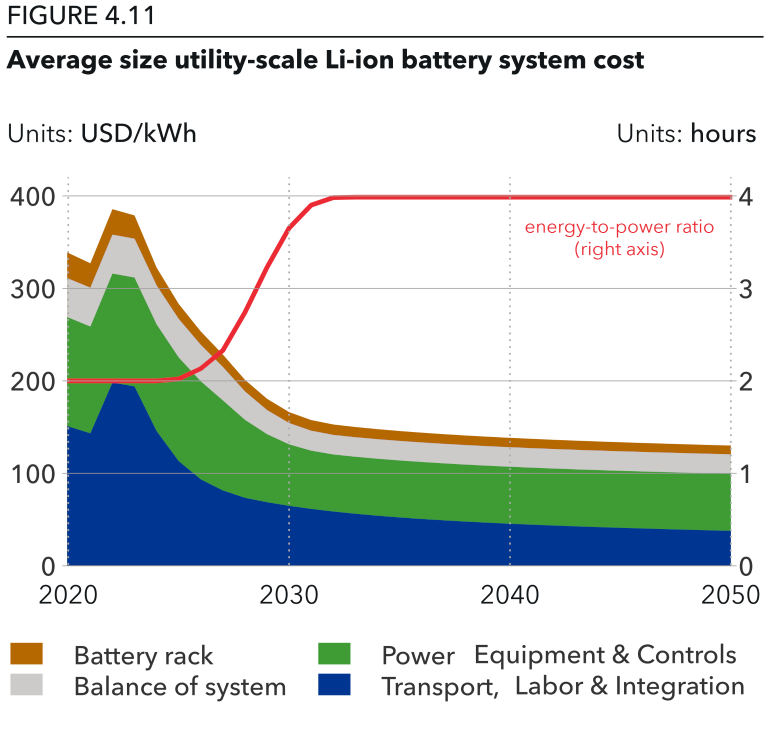Standalone storage takes center stage in 2023
The past year has transformed the North American energy landscape, bringing seismic shifts, groundbreaking innovations, and industry-defining moments. As we enter 2024, DNV’s experts will write a series of blogs to dissect the major trends and developments from 2023 and provide insight on what we can expect in 2024.
When we look back at the 2023 U.S. and Canadian energy storage markets, we will remember it as the first full year in the Inflation Reduction Act (IRA) era. It will stand out as the year standalone storage hit its groove—especially when it comes to financed projects. The IRA opened the door for standalone storage projects to receive the federal investment tax credit (ITC) which had previously only been available to energy storage projects charged by renewable energy. In our role as independent engineers providing technical due diligence to support the various stages of tax equity and debt financing, DNV supported over two gigawatts of energy storage project transactions in 2023. Of those 30+ storage projects, nearly half were financed as standalone storage. DNV expects this trend to continue for the considerable future, as shown below in Figure 1 taken from DNV's 2023 Energy Transition Outlook North America report, as standalone storage can be placed in precise locations to maximize the value to the grid and storage asset, whereas solar charged storage must be placed in solar-friendly locations.

Figure 1 – Utility-scale storage power capacity additions (North America).
Source: DNV’s Energy Transition Outlook North America.
There are several other trends from 2023 that we expect to see continue in 2024 and beyond.
Continued storage market growth
It is exciting to be near the inflection point in a market poised for accelerated growth. Figure 1 highlights annual installations that are expected to quintuple over the next few decades cumulatively exceeding a terawatt of installed capacity by 2050. While most of the growth is expected in the utility scale segment, there is no shortage of development in behind the meter residential and commercial & industrial (C&I) storage applications. We are actively engaged in some of the first distributed generation standalone storage portfolios and expect continued opportunities to develop for the financing of smaller standalone storage projects, especially in the C&I segment where a business case for retail utility bill savings and state incentives can be consolidated into contracted revenue streams between developers and building owners. As storage opportunities abound, DNV is committed to scaling its capabilities to meet market demands.
Storage cleans up fossil fuels
With market growth comes innovation—not just in technology but also in location and use case. Energy storage projects are popping up in new sites, with the latest trend featuring co-location at aging fossil fuel power plant sites. By leveraging the infrastructure of existing power plants, developers have been able to build storage projects that can provide services to the grid that are cleaner and more valuable than running low-capacity factor fossil power plants. DNV has provided diligence to support the financing of several storage projects at existing natural gas plants and expects this market segment to continue to expand among traditional fossil fuel independent power producers (IPPs).
Safety remains critical
Innovative storage siting facilitated by the IRA, while incredibly beneficial to the industry and grid, has some drawbacks. Storage sited alongside utility scale solar projects tend to be in remote locations posing limited direct exposure to the public should a safety event occur. As a few battery fires in 2023 demonstrated, standalone storage sited closer to homes and businesses presents a unique technical and public perception challenge. DNV is involved in several initiatives across the U.S. and Canada to support permitting agencies, fire departments, storage product manufacturers, and storage project developers to improve their ability to evaluate safety risks and reduce the probability of thermal events across numerous dimensions.
Lithium-ion battery prices return to Earth
After the storage supply chain crunch of the Covid-era, the market is seeing prices return to pre-Covid levels and below—especially for some of the proposed megaprojects topping out above a GWh. The supply side dynamics have shifted significantly from the Covid-era where developers were competing hard for attention from battery suppliers to now where we see suppliers competing hard on price to build market share. We expect these dynamics to persist and for pricing to continue to decrease further in the near term, supporting continued market growth. These price decreases result from a combination of incremental technology improvements and an expected 4x increase in global manufacturing capacity by 2030 [1].

Figure 2 - Average size utility-scale Li-ion battery system cost
Source: DNV’s Energy Transition Outlook North America.
U.S. lithium-ion battery manufacturing kicks off in earnest
Among the most rapidly expanding regions of manufacturing growth is the U.S.—which is expected to grow nearly 10x from a scant 0.11 TWh today to over 1 TWh of capacity by 2030 [1]. Again, the IRA is to thank with its incentives supporting domestic manufacturing tax credits alongside the adder to the ITC for projects utilizing domestically manufactured products. Until we see a concerted response from the EU, manufacturers will continue to focus investment in new capacity in the U.S. While some details remain to be ironed out for exactly how domestic content is quantified and measured, DNV has been engaged in the diligence for lithium-ion battery manufacturing facility financing in the U.S. in 2023 and globally for several years prior, allowing us to support clients and investors as they navigate this market area.
Lithium-ion is not alone
DNV expects lithium-ion battery products to continue to dominate the market, especially projects receiving financing which tend to require strong track records. However, novel storage technologies are making inroads into various niche segments of the market, often with support from public funding or incentive programs for pilot projects. While lithium-ion batteries include a wide range of specific chemistries, form factors, and sizes, non-lithium-ion products encompass technologies as diverse as underground compressed air storage to flow batteries, gravity-based systems, thermal products, and more, making it challenging to compare each side-by-side or against the lithium-ion incumbents. Many novel technologies are designed for longer duration storage than lithium-ion.
To secure financing, regardless of the technology, new products tend to require independent review, testing, and field validation (2024 Battery Scorecard coming soon!), and they must include performance guarantees that support the use case and lifetime proposed for a project. Alongside the technology reviews (a/k/a bankability studies) that DNV has performed on lithium-ion products that account for 95%+ of the North American market, our experts have evaluated several novel storage technologies and will continue to expand its library to a more diverse array of storage products seeking to secure financing.
Financing gets a facelift – ITC transferability
Just a short pre-IRA time ago, energy storage was financed only if it was physically charged with renewable energy, namely by co-locating with a solar project and ensuring controls managed storage charging to coincide with solar production. The IRA opened up two new opportunities: the ITC for standalone storage (discussed above) and ITC transferability. ITC transferability enables a project to sell its investment tax credits instead of requiring tax equity investors (e.g., big banks) to take ownership over the project for a period of time to monetize the tax credits and depreciation benefits. [2] Transferability enables a more diverse pool of investors to invest into energy storage projects with lower administrative burden, diligence, and transaction costs. DNV has already supported storage ITC transfer deals that topped USD 1 billion in tax credit sales across over 700 MW of storage projects. We expect to see more in 2024 and will have a webinar on the topic in the first half of this year, so stay tuned!
2024 and beyond
Between the policy support of the IRA, technological improvements, manufacturing growth, and innovative business models, it is hard to overstate the tailwinds supporting rapid and continued energy storage market growth in 2024 and beyond. DNV is equipped to support this growth by leveraging its decades of experience supporting the wind and solar industries and its 40+ dedicated energy storage consultants and engineers located across the U.S. and Canada.
Speak with DNV storage experts at the 2024 Intersolar/ESNA conference January 17-19th in San Diego—or contact us here to learn how we can support you.
[1] https://www.iea.org/data-and-statistics/charts/lithium-ion-battery-manufacturing-capacity-2022-2030
[2] To learn more: https://woodlawnassociates.com/tax-equity-101/
1/16/2024 3:00:00 PM
